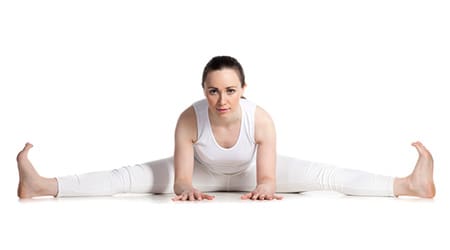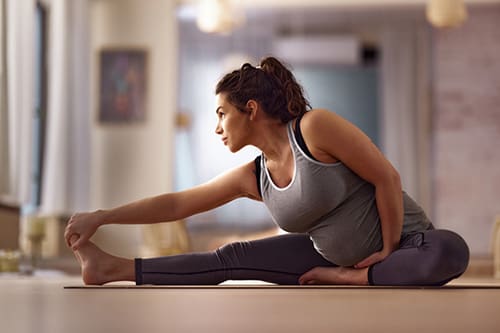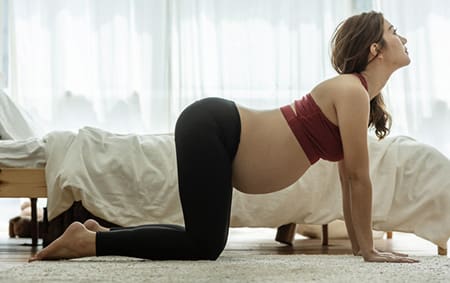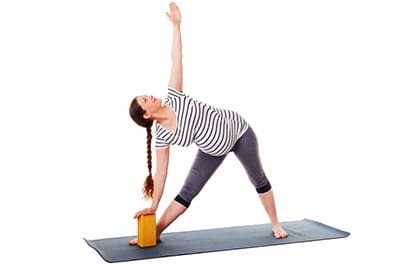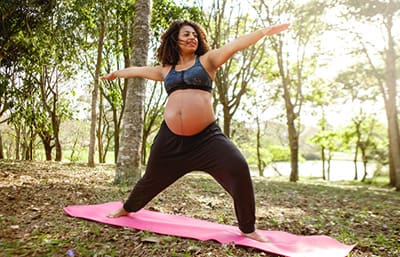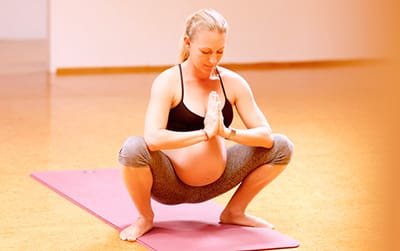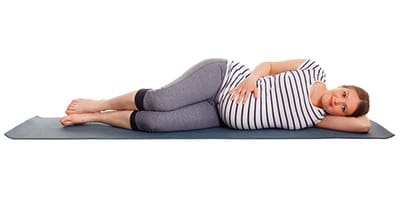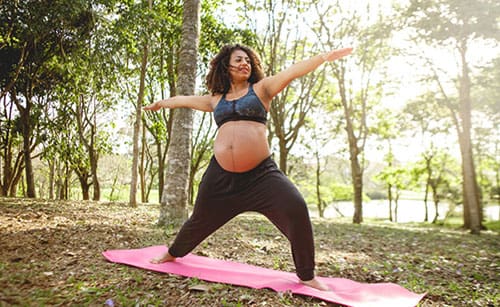
These movements can support both mental and physical relaxation, relieve pregnancy discomforts, and encourage a positive mindset. Plus, you’ll gain valuable skills to adapt to the many changes of pregnancy.
Pregnancy puts a lot of demands on your body, so it’s important to check in with yourself each day. Always listen to your body—tweak something or skip it altogether if it doesn’t feel right. A prenatal yoga pose that feels great one day might feel awkward or even uncomfortable the next.
Be sure to check with your doctor before starting any exercise routine. And if you’re unsure, a certified prenatal yoga instructor can help guide you safely. Keep reading to explore prenatal yoga poses for each trimester, its benefits, and important precautions.
Prenatal Yoga Poses – First Trimester
You can usually keep up with your regular activities in the first trimester—just be sure to make any necessary adjustments. Focus on building strength and easing tension, especially in your lower back and hips.
Gentle forward bends are generally fine, but take it slow, and don’t push yourself into anything that feels uncomfortable.
It’s best to avoid:
- Deep backbends, intense twists, and extreme forward bends
- Strong abdominal contractions
- Inversions (unless you’re a pro)
- Jumping, hopping, or bouncing
- Hot yoga
Seated wide-angle forward bend
This pose will increase flexibility in your hips, legs, and lower back while building strength in your pelvis, lower back, and spine.
If you have tight hamstrings, just place cushions or blocks under your knees.
- Sit on the edge of a cushion or a folded blanket. Move both legs to the side to form a “V” shape. Allow your pelvis to tilt forward.
- Reach your arms overhead.
- Bend at your hips as you fold your torso forward.
- Place your hands in front of you or take hold of your big toes.
- Hold this position for around one minute.
Head-to-knee forward bend
This forward bend will stretch your back, hips, and legs. Plus, it promotes digestion, strengthens your back muscles, and encourages relaxation.
You can use a strap around the ball of your foot to help you stretch, but avoid bending too far forward. Place a cushion or a yoga block under either knee if you need support.
- Sit on the edge of a cushion, yoga block, or folded blanket with your left leg stretched out.
- Bring the sole of your left foot to the inside of your right thigh.
- Inhale and reach your arms overhead.
- As you exhale, gently fold forward, keeping your torso long.
- Rest your hands on your body or the floor.
- Hold for up to a minute, then switch sides.
Cat-cow pose
Cat-cow is a popular yoga pose that can relieve tension, boost circulation, and loosen the spine. It provides a nice, relieving stretch throughout the neck, shoulders, and back.
- Get on all fours.
- Inhale as you drop your belly, lift your chest, and look up.
- Exhale as you tuck your chin, round your back, and lift your spine.
- Keep moving through this flow for up to a minute.
Prenatal Yoga Poses – Second Trimester
In the second trimester, your body ramps up production of relaxin, a hormone that loosens your muscles, tendons, and ligaments to prepare for birth. While this extra flexibility might feel great, you’ll need to be mindful not to overstretch. Instead of pushing to your max, stay within a comfortable range to avoid discomfort or injury.
Here’s what to skip during the second trimester:
- Deep backbends, intense twists, and extreme forward bends
- Strong abdominal contractions
- Inversions (unless you’re a pro)
- Jumping, hopping, or bouncing
- Hot Yoga
- Lying on your back or right side
Bound Angle Pose
Also known as the butterfly stretch, this pose increases circulation, supports digestion, and encourages relaxation. It also helps loosen up your lower back, hips, and inner thighs—key areas for preparing your body for delivery.
- Sit on the edge of a cushion, yoga block, or folded blanket to let your pelvis tilt forward.
- Press the soles of your feet together.
- Bring your feet closer to your hips for a deeper stretch.
- Ground your lower body as you lengthen your spine.
- Interlace your fingers under your pinky toes or rest your hands on your ankles or shins.
- Hold for up to a minute, then repeat 2–4 times.
Child’s Pose
This calming pose helps release tension in your shoulders, chest, and lower back while improving flexibility in your spine, hips, and thighs. It’s a perfect way to reset, breathe deeply, and connect with your body.
Widen your toes if your knees feel uncomfortable or to make room for your belly.
- Start on all fours.
- Bring your big toes together
- Spread your knees wide
- Sink your hips back onto your heels.
- Extend your arms forward
- Relax your forehead toward the floor.
- Hold your body in child’s pose for up to a minute while taking slow, deep breaths.
Triangle Pose
This energizing pose strengthens your body while easing neck and back tension. If you need help with balance, try shortening your stance or standing near a wall for extra support.
- Start in a standing position.
- Step your left foot forward to widen your stance, keeping your left toes pointed straight ahead and your left leg straight.
- Angle your right foot slightly for better stability.
- Open your hips and torso to the right.
- Slowly lower your left hand toward your left ankle. You can rest it on a yoga block, your leg, or the floor—whichever feels best.
- Extend your right arm up, aligning it above your right shoulder with your palm facing outward.
- Hold for 30 seconds, then switch sides.
Prenatal Yoga Poses – Third Trimester
Most women have a harder time breathing and moving because their baby is now taking up more space. Rest as much as you’d like, take it easy, and move gently during this time.
In your third trimester, avoid:
- Intense backbends or twists
- Excessive forward bends
- Strong ab contractions
- Inversions
- Jumping, hopping, or bouncing
- Lying on your right side
- Lying on your back
- Hot Yoga
Warrior II
This pose strengthens your body, improves circulation, and opens your hips. It can also help with neck and back pain. As you align your body, the Warrior II pose allows you to focus on your center of gravity. If you need support, try performing this pose next to a wall. And if the pose is feeling a bit too intense for you, shorten your stance or lessen the bend in your front knee.
- Begin by standing at the back of your mat. Then, step back with your left foot and slightly turn your toes out to the left.
- Align the inside of the left foot so it’s in line with the right heel.
- Open your hips to face the long edge of your mat.
- Raise your arms to parallel the floor, with your palms facing down.
- Bend your right knee, ensuring it doesn’t extend past your ankle.
- Gaze over your front hand and hold the pose for 30 seconds.
- Repeat on the other side.
Garland pose
This deep squat encourages digestion and opens your hips. If you need support, try sitting on a yoga block or stack of cushions. You can also modify the pose by positioning your mat near a wall or chair for balance.
- Stand with your feet situated slightly wider than your hips
- Turn your toes out at an angle.
- Slowly bend your knees
- Lower your hips toward the ground.
- Press your palms together at your chest.
- To encourage the stretch, press your elbows into your knees.
- Hold the pose for up to 30 seconds.
Side corpse pose
Here’s a beneficial pose that relieves fatigue and enhances relaxation.
- Lie on your left side.
- Place a cushion under your head.
- Keep your left leg straight.
- Bend your right knee toward your chest, then layer cushions under it for support.
- Relax in the side corpse pose for 15 minutes.
Use Caution With Prenatal Yoga
You know your body best, so listen to its signals and choose what feels right each day. It’s all about taking it easy—opt for a gentler pace and avoid pushing your limits or overheating.
Select prenatal yoga poses and classes that focus on building strength while still allowing opportunities for relaxation. Transition in and out of poses slowly, ensuring you can breathe comfortably throughout each movement, and avoid holding your breath.
When twisting, aim to initiate the movement from your shoulders or chest instead of your lower back or abdomen. Doing so helps prevent unnecessary pressure on your belly.
It’s important to honor your body’s comfort level—if a pose doesn’t feel right or puts undue pressure on your abdomen, don’t hesitate to modify or skip it. Use a wall or chair for support for added stability during standing or balancing poses.
Should you encounter any unusual symptoms during or after your practice, consult your doctor or a certified yoga instructor before continuing.
Stop your practice if you experience:
- Nausea or lightheadedness
- Overheating
- Dehydration
- Unusual vaginal discharge, spotting, or bleeding
- Numbness
Benefits of Prenatal Yoga Poses
Prenatal yoga helps reduce anxiety and alleviate fatigue, boost energy levels, and enhance sleep quality.
Building strength and endurance through yoga prepares you for the journey of pregnancy and delivery. Research shows that practicing prenatal yoga poses can lead to healthier birth outcomes, improve your baby’s Apgar scores, and reduce the likelihood of emergency C-sections and preterm labor.
Yoga poses stimulate digestion and enhance circulation, minimizing swelling and inflammation, especially in your joints. You’ll enhance your body awareness, strengthen your spine for better posture, and develop balance as your center of gravity shifts. We hope you dive into those prenatal yoga poses and feel empowered throughout your pregnancy. Namaste!
Editor’s Note: This article was originally published on April 1, 2014, and has since been updated.

